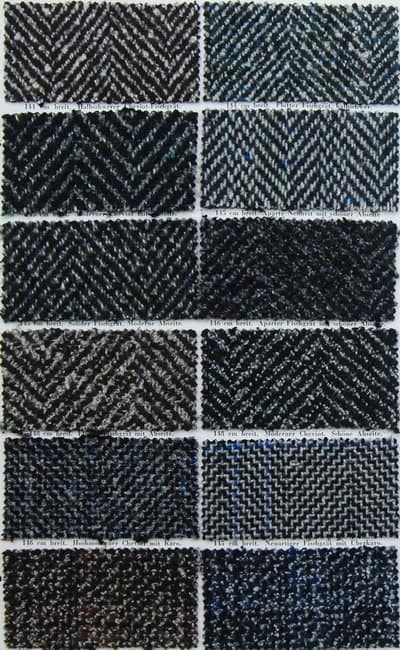It’s been a little while since our last vintage fashion illustration.
Today, we want to look at certain fabrics and illustrations from a German fabric book for the season 1938/1939. The pictures were kindly provided by our contributor Moritz Kickhöfen. I find these particularly intriguing because we can see the illustrations as well as the fabrics worn by the characters!
Most of the fashion illustrations in Apparel Arts do not have exact matching fabric swatches and so, we can only imagine what the real cloth actually looked like. As you probably noticed, the drawn fabrics worn in fashion illustrations never quite look like the real thing. The original fabrics were darker and more complex in color.

Loden
First, let’s start with Loden fabric. Loden is a fabric that is similar to broadcloth, and typically comes in colors of olive green, grey-brown, black or red-brown. Traditionally, these fabrics were woolen and not worsted. In Austria, the Walkloden is still rather popular. The surface of this particular loden is felted with acid and pressure so the fabric structure is not visible anymore. However, unlike a real felt, it is still a woven fabric.
Two gentleman in Loden garments:


On the left, we can see a Norfolk suit in a grey windowpane. Of course, it has a belt and patch pockets with flaps. Interestingly, the collar is very wide and the general silhouette of wide shoulders, tapered waists and full cut trousers were also popular in continental Europe, not just in the UK and the US.
On the right, we see a dapper gent in a single breasted overcoat with raglan sleeves and an Ulster collar.
Both of them look rather young and consequently, they wear snap brim hats, the new style at the time.

Tricot Loden
Apparently, these garments were made out of Tricot Loden, a special form of the fabric that is more flexible and not woven; it is rather a warp-knitted material. Take a look at the pictures to the left.
Casual Garments
Next, let’s look at these two casual garments.
On the left, we can see a classic single breasted sportscoat with rather natural wide shoulders, waist suppression and full cut, cuffed, brown trousers. It is combined with a grey-red polka dot tie, light blue shirt and a velour Trachten hat.


While the trousers look plain in the illustration, the fabric swatches reveal that they have a subtle herringbone pattern, which lends the outfit more depth. Also, we can see how lively the houndstooth really is.
On the right, we can see a plus four knicker bocker combination that was often worn for hiking or hunting. While the coat is plain grey, the trousers have a nice windowpane. It is combined with a light grey shirt, striped tie, sweater vest, special socks and brown wingtip brogues.
Overcoats

Finally, we have two men in heavy Cheviot overcoats.
On the right we can see an Ulster with a very complex fabric and 10 buttons. This kind of overcoat is available almost exclusively from bespoke tailors. The rust brown pants and snap brim hat harmonize with the orange scarf. Overall a great, classic yet individual combination.
On the left, we see a person in a grey suit with a diamond patterned scarf, and a heavy overcoat made of a wide herringbone fabric.
The check lining looks very neat in my opinion, especially since it relies on the same color palette. Paired with a snap brim hat, he is ready for the cold winter.
Note, all gentlemen wear light colored, daytime gloves!

Also, note the variety of herringbone fabrics – compared to current offerings the variety is simply amazing.
Altogether, the vintage fabrics were of course much heavier and not as soft as today’s cloth. However, they did certainly drape well and many of them looked fantastic.
Personally, I am a great fan of mixing vintage garments with current wardrobe items. Have you ever had something made of vintage fabric? or do you wear vintage garments occasionally? What are your favorite periods for men’s clothing?

Wonderful article! Information on vintage mens fabrics is scarce and difficult to come by. Identifying vintage mens fabric is even trickier since the fabrics are not often found and are unusual.
Thanks for your comment Nan. As I can see from your website, you do offer a number of vintage fabrics. What kind of vintage suiting cloth do you have?
Impressive … very impressive. And my favourite period without exception will have to be the ’30’s.
The drape and look of these fabrics is certainly unique.